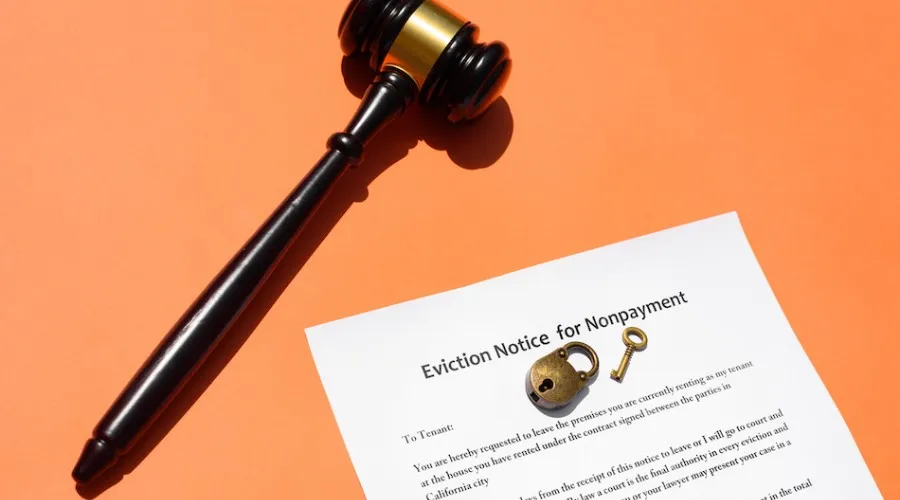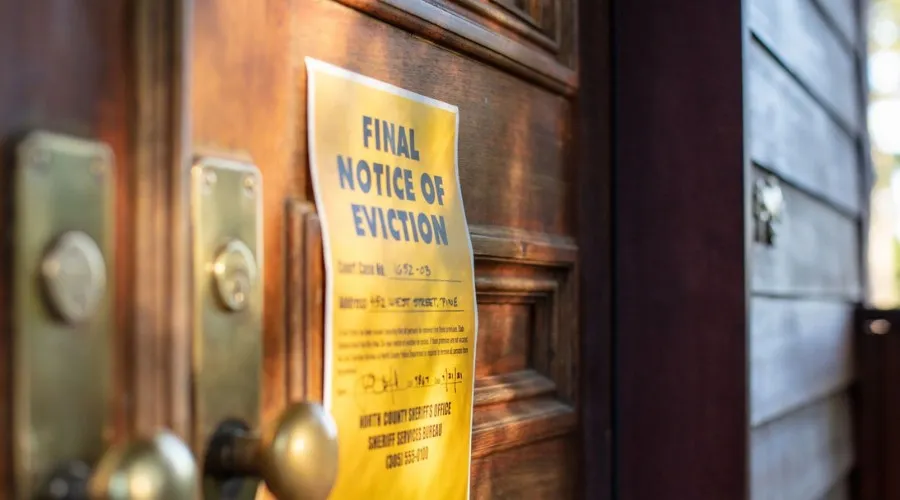Evicting a tenant in Connecticut requires landlords to follow a legally defined process that can quickly become complex. This 2025 guide simplifies each step to help you stay compliant and avoid costly delays. For added support with notices and documentation, LeaseRunner can help keep your eviction process in Connecticut streamlined and legally sound.
Recent Eviction Legal Updates in Connecticut (2025)
In 2025, Connecticut updated its eviction laws to strengthen tenant protections and clarify landlord responsibilities, aligning with Connecticut General Statutes § 47a-23 to § 47a-42. These changes significantly impact how the eviction process in Connecticut unfolds—from notice delivery to court procedures.
Key Updates Effective in 2025:
- Mandatory Tenant rights notice: All eviction notices, such as the Notice to Quit, must include information about free legal counsel for low-income tenants, as part of the expanded Right to Counsel Program.
- End of UniteCT program: The UniteCT emergency rental assistance program closed to new applications on February 28, 2025, requiring landlords and tenants to seek alternative solutions for nonpayment issues.
- Clarified squatter eviction process: Landlords can serve a 7-Day Notice to Quit to remove squatters, with sheriffs authorized to execute evictions if the squatter does not vacate.
- Ban on Self-help evictions: Actions like changing locks or cutting utilities without a court order are strictly prohibited, with penalties up to two months’ rent or double the tenant’s damages.
- Eviction Prevention Fund Available: Tenants facing eviction may still seek aid through Connecticut’s Eviction Prevention Fund, accessible via the UniteCT Call Center as of early 2025.
- Market Pressure & Reform Calls: With Connecticut’s rental vacancy rate at just 7% and homelessness up 13% in the past year, housing advocates continue pushing for broader eviction reform.
- Digital Payment System Accountability: Senate Bill No. 1302 requires courts to consider failures in landlords’ online payment systems when evaluating rent nonpayment cases.
- Grace Period & Late Fee Cap: Tenants are entitled to a 9-day grace period before late fees apply. Fees are limited to $5/day (up to $50) or 5% of overdue rent, whichever is less.
Landlords should review the statutes and consult legal counsel to ensure compliance. Tenants can access support through the Connecticut Fair Housing Center or CTLawHelp.org.
Valid Reasons for Eviction in Connecticut
Under Connecticut law, landlords must have a legally valid reason to evict a tenant. The following are the most common grounds for initiating an eviction process in Connecticut, including nonpayment of rent, lease violations, or refusal to vacate after lease expiration.
Non-Payment of Rent
Failing to pay rent on time is one of the most common legal grounds for eviction in Connecticut. Under Connecticut rental laws, a landlord has the right to begin eviction proceedings if a tenant does not fulfill their obligation to pay rent as agreed in the lease.
For tenants on a week-to-week lease, rent is officially late 4 days after the due date. For example, if rent is due on July 10th, it becomes late on July 14th.
For month-to-month or fixed-term leases, rent is considered late 9 days after the due date. If the rent is due on the 1st, the payment is late if it hasn’t been made by the 10th.
Landlords may provide a grace period, but it must be explicitly written into the lease agreement.
Before initiating an eviction case, landlords are legally required to serve the tenant a 3-Day Notice to Quit. This notice informs the tenant that they have three days to either pay the overdue rent or move out of the property. If the tenant fails to do either, the landlord may proceed with filing an eviction lawsuit in court.
Learn more about creating a compliant lease at LeaseRunner’s free lease agreement templates.

Lease violation
If the tenant doesn’t comply, the landlord can escalate the matter in court. This escalation marks a critical stage in the eviction process in Connecticut, especially when lease terms are clearly outlined.
Common lease violations that may lead to eviction include:
- Causing physical damage to the rental unit
- Keeping unauthorized pets in a no-pet property
- Smoking in smoke-free buildings
- Ignoring health and safety regulations (such as improper trash disposal or tampering with electrical wiring)
When a tenant breaches any of these terms, the landlord must issue a 15-Day Notice to Comply or Quit. This gives the tenant 15 days to correct the violation or vacate the property. If the tenant doesn’t comply, the landlord can escalate the matter in court.
Unlawful detainer
Unlawful detainer refers to a situation where a person stays in a rental property without the legal right to do so. In Connecticut, if a tenant refuses to leave the property after receiving a proper notice to vacate—or never had a legal lease in the first place—they may be considered an unlawful occupant.
Landlords can file an eviction case based on unlawful detainer after serving the appropriate Notice to Quit. This is a common step in the eviction process in Connecticut when tenants remain without legal right. For step-by-step legal compliance, visit the Connecticut landlord-tenant law summary.
Expired lease or Tenant at will
When a tenant remains in the rental unit after the lease has expired and the landlord chooses not to renew it, the tenant becomes a holdover tenant. Under Connecticut law, the landlord can begin eviction if no new lease has been signed and the tenant refuses to leave.
In both cases, landlords must serve a 3-Day Notice to Quit for Lapse of Time. If the tenant refuses to leave, the landlord can proceed with a court eviction.
Pro tip: Protect yourself against holdover situations by running an eviction history check before signing with a new tenant.

Squatter & adverse possession
Squatters—individuals who occupy property without the landlord’s consent—can be removed using a 7-Day Notice to Quit, followed by formal eviction if necessary. While rare, a squatter may claim ownership through adverse possession if they meet strict legal criteria over a long period. Learn more about Connecticut squatter rights to understand how state laws apply in these cases.
If the tenant doesn’t comply, the landlord can escalate the matter in court. This escalation marks a critical stage in the eviction process in Connecticut, especially when lease terms are clearly outlined. Learn more about the legal difference between squatting and tenant holdovers at LeaseRunner's legal insights.
Serving an Eviction Notice in Connecticut
Understanding the proper procedure for serving notices is crucial to ensure a smooth eviction process in Connecticut. Errors in delivery or missing content can result in dismissal of the case.
What types of eviction notices are used in Connecticut?
In Connecticut, landlords use specific eviction notices depending on the reason for eviction. The primary types include:
- 3-Day notice to quit for nonpayment of rent: Used when a tenant fails to pay rent on time. The tenant has three days to pay or vacate.
- 30-Day notice to quit for lease violations: Issued for violations like property damage or illegal activity. For month-to-month tenancies, this notice may also be used to terminate the tenancy without cause.
- 3-Day notice to quit for lapse of time: Applies to oral leases or when a written lease expires, requiring the tenant to vacate within three days.
- Kapa notice (Pre-termination notice): Required in some cases before the formal Notice to Quit, giving tenants 15 days to correct certain lease violations, like unauthorized pets or minor breaches, except for nonpayment or serious nuisance.
Each notice must comply with Connecticut General Statutes §47a-23.
What content should be included in an eviction notice?
An eviction notice in Connecticut must include specific details to be legally valid:
- Tenant’s name and address: Clearly identify the tenant and the rental property’s address.
- Reason for eviction: Specify the cause, such as nonpayment of rent, lease violation, or lease expiration.
- Date of notice: Include the issuance date and the deadline for compliance (e.g., 3 or 30 days).
- Landlord’s information: Provide the landlord’s name, signature, and contact details.
- Statement of intent: Indicate that failure to comply will result in legal action to recover the property.
- Compliance with Kapa notice (if applicable): For certain violations, confirm a pre-termination notice was served, allowing the tenant a chance to remedy the issue.
Read more: Connecticut Rent Laws: Late Payments, Rent Changes, and Payment Guidelines
How to legally serve an eviction notice in Connecticut?
Understanding how to legally serve a notice is a foundational step in the eviction process in Connecticut, as improper service may delay or void the case entirely. Connecticut law outlines strict procedures for serving an eviction notice:
- Proper server: The notice must be served by a state marshal, sheriff, or, in some cases, an “indifferent person” (a disinterested third party over 18, not the landlord).
- Methods of service:
- Personal delivery: Hand the notice directly to the tenant.
- Abode service: If the tenant is unavailable, leave the notice at the tenant’s residence, typically by affixing it to the door and mailing a copy via certified mail.
- Timing: The notice period (e.g., 3 or 30 days) begins the day after service. For example, a 3-day notice served on July 1 starts counting on July 2.
- Proof of service: The server must complete a return of service, documenting the date, time, and method of delivery, which is filed with the court if eviction proceedings follow.

What mistakes should landlords avoid when serving a notice?
Landlords must avoid common errors to ensure the eviction process is legally sound:
- Use the correct notice type and timing: Serving the wrong notice (e.g., a 3-day notice instead of 30 days) or miscalculating the timeframe can invalidate the eviction process.
- Include complete and specific content: Failing to clearly state the reason for eviction or omitting essential elements like the landlord’s signature can make the notice legally defective.
- Serve the notice properly: Delivering the notice yourself or not using a qualified party (like a state marshal) may result in improper service.
- Avoid retaliatory or discriminatory conduct: Evicting tenants for protected actions (e.g., complaining about conditions) or based on race, disability, etc., violates Connecticut law.
- Refrain from self-help eviction methods: Actions like changing locks, shutting off utilities, or removing belongings without court approval are illegal and subject to penalties.
A Step-by-Step Guide to the Eviction Process in Connecticut
This guide outlines the steps for legally evicting a tenant in Connecticut, ensuring compliance with state laws at every stage of the eviction process in Connecticut—from notice to final writ of execution.
Step 1 – Serve the appropriate notice
The landlord must serve the correct notice based on the eviction reason, as required by Connecticut law:
- Nonpayment of Rent: Issue a 3-Day Notice to Quit, requiring the tenant to pay rent or vacate within 3 days.
- Lease Violation: Serve a 30-Day Notice to Quit for issues like property damage or illegal activities. In some cases, a Kapa Notice must be served first, giving the tenant 15 days to remedy minor violations (except serious nuisances).
- Holdover Tenancy: Issue a 3-Day Notice to Quit for Lapse of Time for oral leases or expired written leases.
- Illegal Activity: Serve a 3-Day Notice to Quit for illegal activities, such as drug trafficking.
Step 2 – File a summary process complaint
If the tenant does not comply with the notice, the landlord files a summary process complaint with the Superior Court under Connecticut General Statutes § 47a-23. Complete the complaint form, detailing the eviction reason and including copies of the notice and proof of service. Submit it with the filing fee (typically $175-$200) to the court in the jurisdiction where the property is located.
Step 2 – Serve the Court Summons and Compliant
The court issues a summons and complaint, which must be served on the tenant by a state marshal or sheriff. Service can be made by direct delivery or by leaving the documents at the tenant’s residence with a certified mail copy, at least 5 days before the court date.

Step 4 – Wait for the Tenant’s response
The tenant may file an “appearance” within 2 days of receiving the summons to indicate participation or an “answer” to contest the claims. If the tenant fails to respond, the landlord can request a default judgment.
Step 5 – Attend the court hearing
At the hearing, the landlord presents evidence, such as the lease and notice. If the tenant does not appear, the landlord may request a default judgment, allowing eviction without a full hearing.
Step 6 – Request a writ of execution
After a favorable judgment, the landlord requests a writ of execution from the court, typically with a fee. Following a 5-day stay, a state marshal serves the writ, ordering the tenant to vacate within 24-48 hours.
Step 7 – Regain possession of the rental property
A state marshal oversees the tenant’s removal. The landlord inspects the property afterward and complies with laws on abandoned property, storing items for 15 days per Connecticut General Statutes § 47a-42.
Landlords should check Connecticut General Statutes § 47a-23 to § 47a-42. They may also want to get legal advice to stay compliant.
Eviction Timeline & Cost Connecticut Landlords Must Know
After understanding the key steps involved in the eviction lawsuit process, the next crucial step is preparing for the timeline and costs associated with it. Knowing what to expect in terms of duration and expenses helps landlords plan their finances more effectively and avoid unnecessary delays. The table below outlines each stage of the process, including estimated timeframes and fees.
Evictions in Connecticut usually take 4–7 weeks for uncontested cases. Knowing the full timeline helps landlords prepare financially and mentally for the eviction process in Connecticut, especially when delays occur.
Total eviction costs range from $355 to $1,200, including court fees, marshal service, and possible storage fees. Delays or extra costs may occur if the tenant appeals or if you hire a lawyer. Always follow Connecticut General Statutes § 47a-23 to § 47a-42 to stay compliant.
Documentation & Evidence For Eviction in Connecticut
When a tenant contests an eviction, the court will usually schedule a hearing within 7–10 days after receiving their response. During this time, having clear, organized evidence is critical if you want to prove your case and follow Connecticut’s eviction laws correctly.
Record keeping best practicesKeeping Best Practices
Having organized documentation is critical to succeeding in any contested eviction process in Connecticut. Courts expect time-stamped, factual evidence that supports your legal claims.
Here’s how to stay prepared:
- Paper files are not enough – Paperwork can get lost or damaged. Instead, digitize everything.
- Scan and back up your documents – Use cloud storage services like Google Drive or Dropbox to safely store scanned files. This makes it easy to pull up key documents during court.
- Use property management software - Many landlords in Connecticut use tools like Buildium or AppFolio. These help track leases, payments, notices, maintenance requests, and communications all in one place.

Evidence for non‑payment
Showing missed payments, lease terms, and formal notices helps prove your case during the eviction process in Connecticut, especially if the tenant contests the claims.
- Lease agreement – Show the original lease with rent terms and due dates clearly stated.
- Payment history – Provide a log of rent payments (or missed payments), including how and when they were made.
- Returned payments or chargebacks – If a check bounces or a credit card payment is reversed, include those records. Also, add any fees or penalties from the lease.
- Payment reminders – Show any text messages, emails, or mailed notices reminding the tenant about overdue rent. Written records are far more persuasive than verbal conversations.
Evidence for lease violations & Illegal activity
If your eviction is based on a lease breach, such as noise complaints or unauthorized pets, you’ll need clear proof:
- Photos and videos – Capture damage or violations with your phone. These visuals often carry more weight than written claims.
- Security footage – If available, surveillance video showing the violation happening is strong evidence.
- Cited lease clauses – Highlight the specific part of the lease that was broken. Even if it’s not written explicitly, serious violations (like endangering property or others) may still be valid grounds under CT landlord-tenant law.
Pro tip: Save every lease version, notice sent, and tenant response — they all count as part of your legal eviction process in Connecticut.
Property condition records
Documenting the property’s condition is vital to prove damage caused by the tenant or to counter tenant defenses:
- Move-in inspection report: A detailed report, signed by both landlord and tenant, documenting the property’s condition at the start of the lease, with photos or videos.
- Periodic inspection records: These include notes and photos from regular inspections. They are dated and timestamped to help track changes in property condition.
- Damage documentation: Include photos, videos, or repair estimates that show tenant damage beyond normal wear and tear.
- Maintenance requests: These show tenant-reported problems and landlord replies to prove they follow habitability laws.
- Move-out inspection: A final inspection report after eviction, comparing the property’s condition to the move-in report, to support claims for damages.
Landlords should maintain these records meticulously and consult Connecticut General Statutes § 47a-23 to § 47a-42 to ensure compliance with legal requirements. If you're dealing with unauthorized occupants or long-term trespassers, check out the legal guidelines on Connecticut Squatter Rights to understand your rights and next steps.
5 Tips for Connecticut Landlords to Avoid Common Eviction Mistakes
Navigating the eviction process in Connecticut requires strict adherence to state laws to avoid costly delays or legal challenges. Below are five key tips to help landlords steer clear of common pitfalls, ensuring compliance with Connecticut General Statutes § 47a-23 to § 47a-42.
1. Use the correct notice type and timing
Select the appropriate notice (e.g., 3-Day Notice to Quit for nonpayment or illegal activity, 30-Day Notice for lease violations, or Kapa Notice for curable breaches) and ensure accurate timing. For example, a 3-day notice for nonpayment starts the day after service. Using the wrong notice or miscalculating the period can lead to case dismissal.
2. Hire a qualified server
Always use a state marshal, sheriff, or disinterested third party to serve notices and court documents. Self-serving notices or using an unqualified person violates Connecticut law and can invalidate the eviction process.
3. Maintain detailed documentation
Incomplete records can weaken your case in court and cause setbacks during the eviction process in Connecticut. Always keep copies of all notices, communication, and lease terms.
4. Avoid retaliatory or discriminatory actions
Do not evict tenants for complaining about habitability issues or based on protected characteristics (e.g., race, disability). Retaliatory evictions violate Connecticut’s Fair Housing laws and can result in penalties or lawsuits.
5. Refrain from Self-help evictions
Never resort to actions like changing locks, removing tenant belongings, or cutting utilities without a court-issued writ of execution. Such actions are illegal under Connecticut law and can lead to significant legal consequences.
Conclusion
The eviction process in Connecticut is heavily regulated to protect both landlords and tenants. By following the correct legal procedures and avoiding common mistakes, landlords can efficiently navigate the Connecticut eviction process without costly delays. Staying compliant with Connecticut General Statutes § 47a-23 to § 47a-42 ensures your actions are legally sound—protecting your property and your rights.
FAQs
Q1. How long does an eviction take in Connecticut?
The average timeline for a standard, uncontested eviction is 4 to 7 weeks from notice to property recovery.
Q2. Can a landlord evict without a court order in Connecticut?
No. All evictions must go through the court system. Self-help evictions (changing locks, cutting utilities) are illegal.
Q3. What happens if a tenant refuses to leave after the court judgment?
A state marshal will serve a writ of execution, and the tenant has 24–48 hours to vacate. The landlord may then regain possession.



